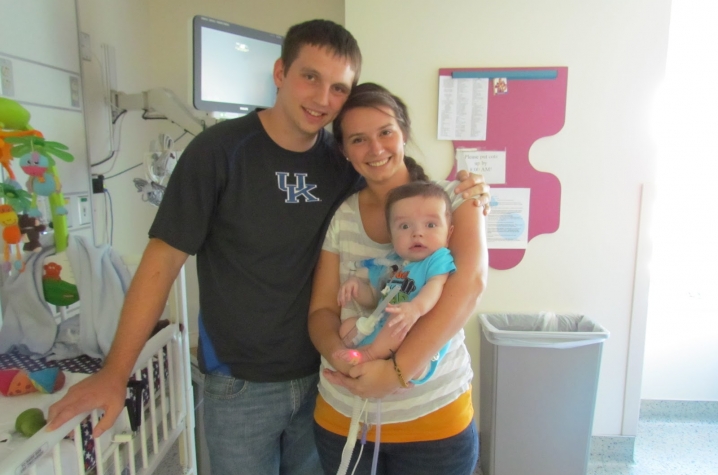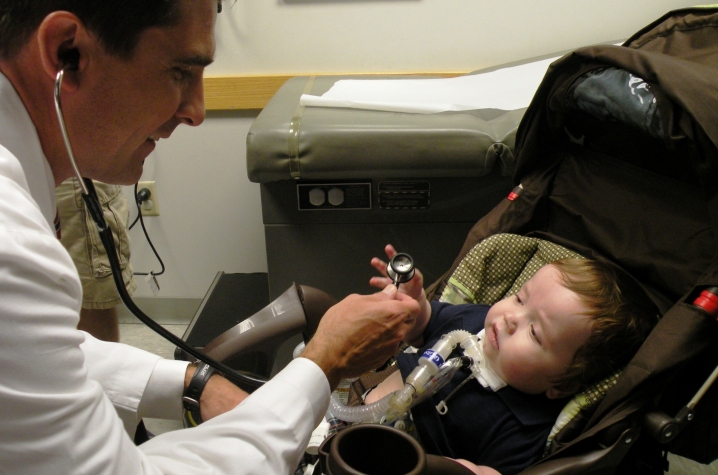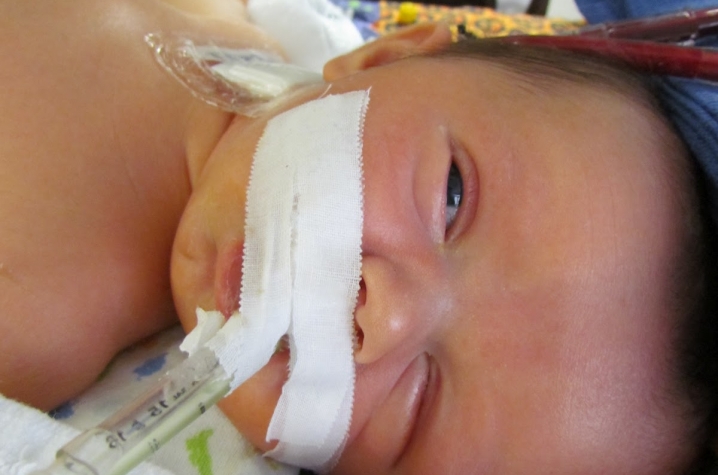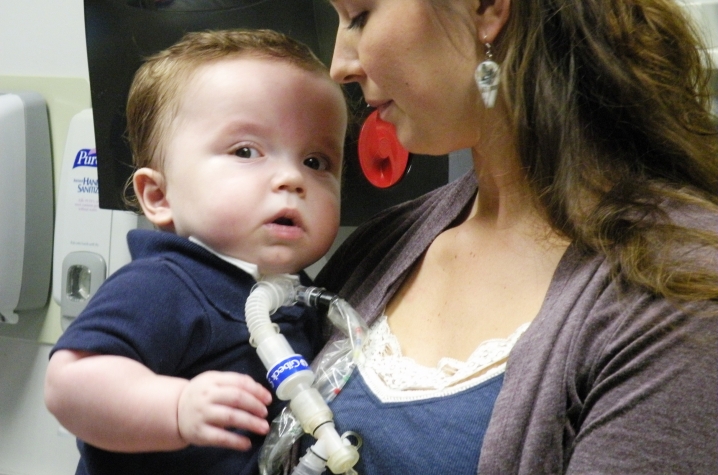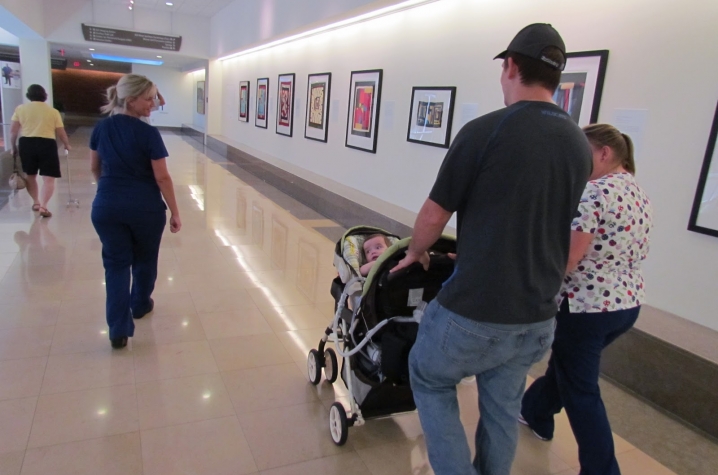ECMO Support Made the Difference Between Life or Death for Young Irvine Patient
LEXINGTON, Ky. (Oct. 24, 2012) — For most babies, reaching the one-year mark is just another milestone on the growth chart. For baby Clay Eaton of Irvine, Ky., who is officially one year old today, it's a miracle.
Clay was diagnosed with a congenital diaphragmatic hernia (CDH) in the 18th week of gestation — a birth defect that severely hampered his chances of survival. The day he was born, his parents, Hannah and Eric, were prepared but anxious for Clay to arrive and start receiving treatment.
"It was really overwhelming, and I was thinking 'This is the calm before the storm,'" Hannah said. "When he came out, I was anxious to hear if there was a cry or not — and he made a little cry, like a whimper. We could hear that little whimper all the way down the hall — and it was good to hear even that small noise."
The average survival rate for babies born with a congenital diaphragmatic hernia is about 60-70 percent; however, due to the severity of Clay's defect, his doctors gave him only a 10 percent chance of survival — unless Clay could receive extracorporeal membrane oxygenation (ECMO) support once he was born, which would raise his survival chances to about 75 percent.
During Hannah's pregnancy, the Eatons were referred to the University of Kentucky, where physicians have utilized ECMO support since 1994. UK houses one of only two comprehensive ECMO programs in the state of Kentucky, and was recently awarded a prestigious ECMO Center of Excellence designation by the Extracorporeal Life Support Organization.
The thought of Clay needing ECMO was frightening, says Hannah, but ultimately their best possible option.
"We were hoping we wouldn't have to use ECMO," Hannah said. "I guess in my mind, ECMO meant really, really sick babies, and I didn't want to think about Clay being a sick baby… but once the time came, there was no other route."
Clay was born on Oct. 24, 2011, via a planned Cesarean section. His small intestines, liver and spleen had formed in his chest cavity, pushing against his lungs. As a result, his lungs were not fully developed, and his heart was pushed over to the right side of his body.
"Neither of Clay's lungs could fully expand," said Dr. Hubert Ballard, director of neonatal and pediatric ECMO at UK. "And that's why ECMO was so important for Clay and for other newborns with similar defects. ECMO is essentially like a prolonged heart-lung bypass — it allowed the machine to do the work of those organs while his lungs healed and expanded."
Clay was placed on ECMO support at only 18 hours old, and remained on the system for eight days so that his lungs could recover. The ECMO support also allowed pediatric surgeon Dr. John Draus and his team to move Clay's internal organs down into the abdomen and construct a diaphragm from mesh to replace the half that was missing.
"Access to ECMO was critically important for Clay, and I do not believe he would have survived without it," said Draus. "Furthermore, I don't believe he would have survived transport to UK if he had been born at a hospital that did not provide ECMO. He was very unstable and there was no time for delay."
Clay and his parents spent the next eight months at Kentucky Children's Hospital. Draus has so far performed eight procedures on Clay, including placement of J-tube (a feeding tube that hooks directly into the jejunum) and further surgery to repair the first mesh diaphragm, which needed adjusting as Clay grew. But on June 26, Hannah and Eric finally got to bring their baby boy home to Irvine.
At home, Clay still requires much specialized care — he is still hooked up to a ventilator to help him breathe, and he still has his J-tube. The equipment requires near-constant supervision for blockages or other problems, but it's all part of being able to stay at home in the comfort of what Hannah affectionately calls their CICU — Clay Intensive Care Unit.
"It was amazing to be able to bring him home," Hannah said. "The doctors and nurses trained us well on using the equipment, and we felt completely comfortable going home."
Now a year old and counting, Clay continues to improve and grow. His pulmonologist, Dr. Michael Anstead, has given the Eatons the go-ahead to begin weaning Clay off of his ventilator. In the next few months, Draus plans to do a procedure to give Clay a G-tube (a feeding tube that will go directly into the stomach) to replace the J-tube, and eventually the Eatons will begin easing him into solid foods.
As he grows, says Draus, Clay's doctors will keep a close eye on him for any potential problems that may occur in the future. Though Clay cannot speak yet, due to his tracheotomy, Draus said Clay is progressing nicely.
"Clay is doing very well given how sick he was," Draus said. "He smiles, looks around, grabs things, and recognizes his parents – many of the things that a 'normal' baby his age does. He will hopefully catch up in the future and have a long, happy life."
Draus places much of the credit for Clay's good health on his parents' devotion to his care.
"Clay's an incredibly lucky boy to have two loving parents taking care of him," Draus said. "I cannot stress enough the value of this for babies who have multiple medical problems."
Hannah, who serves as a full-time stay-at-home mother to Clay, credits the strong support system she has at home — the family members and friends who have always been willing to lend a hand when she or Eric needed a break.
"It's a sacrifice, I guess, to stay at home with him all the time, but I wouldn't want it any other way," Hannah said. "We have lots of family close by who have been a huge help, and that support has made all the difference in his well-being… and ours!"
To learn more about the Eatons' experience, visit Hannah's blog Breathing for Baby Clay.
MEDIA CONTACT: Allison Perry, (859) 323-2399 or allison.perry@uky.edu





